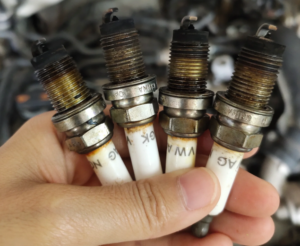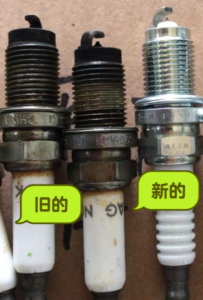Wielu entuzjastów samochodów może mieć pytania: czy podczas konserwacji należy wymienić świece zapłonowe? How often do I change the Świece zapłonowe?
Właściciel samochodu zgłosił problem z naprawą: niewystarczająca moc podczas jazdy, silne wibracje na biegu jałowym, i wysokie zużycie paliwa.

Jak pokazano na rysunku: Volkswagen Sagitar wykorzystuje m.in 60000 kilometrowa świeca zapłonowa, który zmienia kolor na czarny, a styki zostały już przepalone. Złe spalanie prowadzi do niewystarczającej mocy, brak reakcji cylindra, seria szarpnięć podczas jazdy, i wysokie zużycie paliwa.
Podobnie jak nasze części samochodowe, większość z nich korzysta z lin ratunkowych, jak świece zapłonowe. Different materials and brands have different life cycles.
1. Nickel alloy spark plugs 20000 do 30000 kilometrów
2. 40000 kilometers of single platinum spark plugs
3. Dual platinum spark plugs 60000 kilometrów
4. Iridium spark plugs, 80000 kilometrów, itp.
The service life of these spark plugs is only recommended by the parts manufacturer. w rzeczywistości, the vehicle model and driving habits will have an impact on the service life of the spark plugs, so it is judged that if the spark plugs are not replaced.
Personally, it is recommended to disassemble and inspect the spark plugs every 3 years or 60000 kilometers to determine whether to replace them based on their color and contact spacing.
4S stores also have some repair garages that replace them according to the maintenance manual, which saves time, but it’s not easy to make money. It’s better to check and see the specific condition of the quality before making a decision.

There may be many car enthusiasts who see this, but what are the consequences of not replacing the spark plugs?
1. Insufficient power and idle shaking: A decrease in spark plug performance will cause a linear decrease in the engine’s ignition performance, resulting in weak acceleration, insufficient power, and shaking during acceleration.
2. Higher fuel consumption: Abnormal ignition can cause insufficient combustion of the mixture, reduce conversion efficiency, and require more gas for combustion, accelerating fuel consumption.
3. In severe cases, there is also a lack of cylinder work, resulting in a series of uncomfortable jerks.


